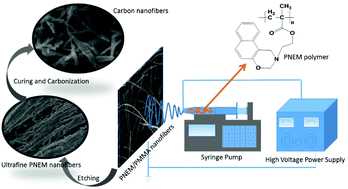Polynaphthoxazine-based 1D carbon nano-materials: electrospun fabrication, characterization and electrochemical properties†
Abstract
We described a route to a core–shell polynaphthoxazine nanofiber that can be fabricated by a single-nozzle electrospinning process using a phase-separated mixed polymer composite solution. The naphthoxazine-based polymer, as the core material, was synthesized by using a hydroxyl-containing naphthoxazine through esterification with methacryloyl chloride and subsequent free radical polymerization. Our results demonstrated that these core–shell structure nanofibres are composed of bundles of regularly structured ultrafine polynaphthoxazine nanofibers as the core and polymethylmethacrylate (PMMA) as the shell, because of the incompatibility of the naphthoxazine-based polymer and PMMA in mixed solvents. To maintain the structural integrity of the fibrous network during the curing process, we carried out the curing reaction in a chemically inert fluid with p-toluenesulfonic acid as the catalyst. After carbonization, the obtained carbon fiber with high nitrogen content (2.2 wt%), resulting from the oxazine ring as the carbon source, showed individual nanofibres without aggregation, and with a mean diameter of less than 30 nm. As an energy storage electrode, these naphthoxazine-based carbon nano-materials have excellent high-rate discharge capacity and low equivalent series resistance.


 Please wait while we load your content...
Please wait while we load your content...